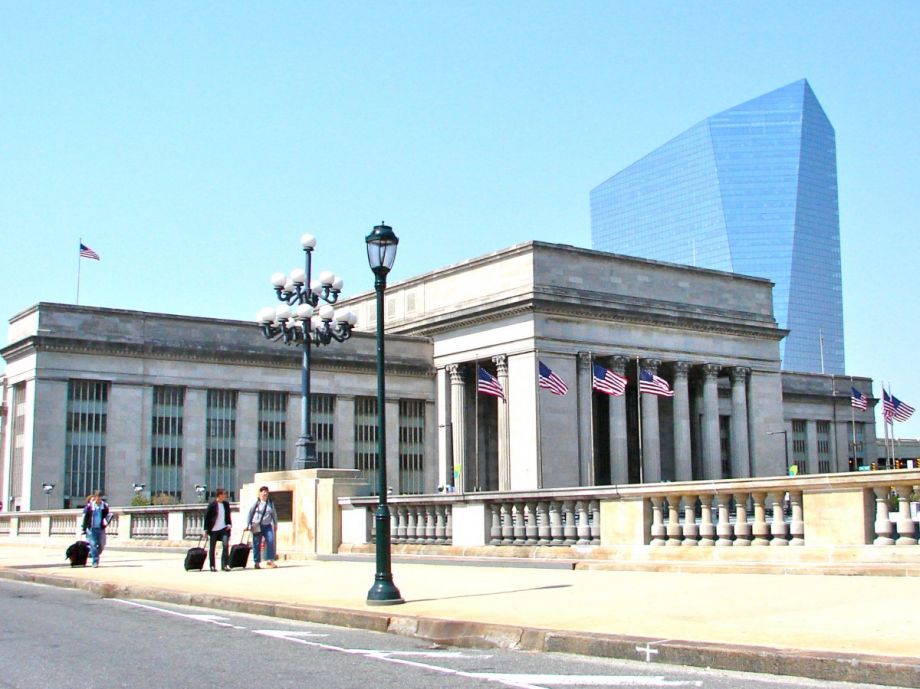Right on the edge of Center City, Philadelphia’s 30th Street Station — one of the region’s two most important transit hubs and situated a short walk to Drexel and Penn’s campuses — has defied the city’s decades-long urban revival. The neighborhood has everything going for it, but little of the development you might expect. Seeking to reverse that, Amtrak and a bevy of other interests have asked architectural firm Skidmore, Owings & Merrill to draw up a master plan, funded by Drexel University and others, for the area around the station, as well as 75 acres of rail yard sprawling out north from the station complex.
The effort comes as the area has seen a few new buildings go up — the Internal Revenue Service now works out of the old post office across the street, and Brandywine Realty Trust (who is participating in this study as well) threw up an office tower called the Cira Centre behind 30th Street and is currently building a rental apartment building geared toward graduate students and young professionals nearby — but still not enough to make it an inviting place for those passing through, especially for Amtrak passengers for whom the neighborhood is the first and last they’ll see on their trip.
The first hurdle that the planners will have to overcome is the area’s zoning. Most of the parcels immediately adjacent to the station are zoned for industrial use only, essentially limiting their use to Drexel or Penn, since the area is too expensive for real industrial uses and the zoning also allows institutional uses. While the universities are no doubt the area’s anchors and will remain the most important employers, a truly urban neighborhood is hard to fashion out of an “eds and meds” monoculture.
Farther from the station, extending down Market Street to 34th Street and the streets farther south, the blocks are zoned for institutional use, again excluding office and residential uses not affiliated with a university or hospital.
Only in select locations — for example, on the block south of the old post office, where Brandywine is building the apartment building — are general residential and office uses allowed. This building is proof that there is a residential market in this location (and why wouldn’t there be, with the easy access downtown and to suburbs for reverse-commutes by regional rail or the highways?), and the first order of business must be changing the zoning so that developers can build housing and office space. This approach would complement the universities rather than allowing the neighborhood to be totally subsumed by them.
Allowing developers to build more densely than the current 400 or 500 percent floor-area ratio limit — which works out to an eight- or 10-story building that fills half its lot, or at most half the density of a modern skyscraper — also wouldn’t hurt the viability of new construction. A more skyscraper-friendly zoning designation of CMX-4 or CMX-5 (as found in Center City proper, University City west of 34th and part of the rail yards) might be more appropriate.
The rail yards behind 30th Street Station are zoned more liberally — commercial and residential uses are allowed in some parts, in addition to institutional space — but the cost of exploiting them is quite high, and it’s not clear that property values in Philadelphia are high enough to justify decked towers.
While decking over rail yards is a tried and true method of generating more developable land in tight urban areas — the New York Central pioneered the concept a century ago, building “Terminal City” atop the yards north of Grand Central Terminal, now some of the highest-rent office space in America — the cost nowadays is steep. In Manhattan, developers are looking for rents in the $80s and beyond per square foot each year to make the towers at Hudson Yards pencil out; in Brooklyn, Forest City Ratner lost hundreds of millions of dollars at Atlantic Yards, in a stadium-cum-housing decking scheme that turned out to be far too ambitious. Office rents in University City, around 30th Street, are the highest in Philadelphia, but the median rent for the highest-quality space is still less than $40 per square foot. New buildings can fetch more, but will it be enough to make an expensive rail yard deck viable?
The rail yard redevelopment scheme may be the most exciting, but it’s also the least likely to happen anytime soon. Efforts should instead be concentrated on making the most of the terra firma to the south and west of the station that’s easiest to build on. Only after that is exhausted should Amtrak, Drexel and others think about building over the yards.
And while Drexel University President John Fry certainly has ambitious urban development plans for Drexel, just as he did at Penn when he was an executive vice president of that university, it’s important to leave room for other developments, to avoid a stifling eds-and-meds monoculture at the footsteps of West Philly.
The Works is made possible with the support of the Surdna Foundation.
Stephen J. Smith is a reporter based in New York. He has written about transportation, infrastructure and real estate for a variety of publications including New York Yimby, where he is currently an editor, Next City, City Lab and the New York Observer.

















